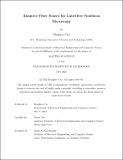Adaptive Fiber Source for Label-free Nonlinear Microscopy
Author(s)
Cao, Honghao
DownloadThesis PDF (6.934Mb)
Advisor
You, Sixian
Terms of use
Metadata
Show full item recordAbstract
Nonlinear microscopy enables label-free visualization of biological processes in live samples at sub-cellular spatial resolution and sub-millimeter penetration depth, enabling the in-vivo study of mechanisms underlying several cellular functions. Due to the low absorption cross-section of the two-photon and three-photon excitation processes, especially for the endogenous fluorophores, high peak power broadband laser sources are important in improving nonlinear microscopy generation efficiency. Multimode fibers (MMFs) are regaining interest as light sources due to their high-dimensional spatiotemporal nonlinear dynamics and scalability for high power. MMF sources with effective control of nonlinear processes would enable new possibilities in many areas, such as high-power fiber lasers, biomedical imaging, and chemical sensing, as well as a platform for investigation of intriguing physics phenomena. In this thesis, we present a simple yet effective way of controlling nonlinear effects at high peak power levels in MMFs. This is achieved by leveraging not only the spatial but also the temporal degrees of freedom during multimodal nonlinear pulse propagation using a programmable fiber shaper that introduces time-dependent disorders. We achieve high spectral-temporal-spatial tunability in the output laser pulses of the MMF, resulting in a broadband high-peak-power source. We further demonstrate its potential as a laser source for nonlinear microscopy through widely tunable two-photon and three-photon excitation. This approach provides possibilities for technological advances in a wide range of fields, such as nonlinear optics, biomedical imaging, and spectroscopy.
Date issued
2024-05Department
Massachusetts Institute of Technology. Department of Electrical Engineering and Computer SciencePublisher
Massachusetts Institute of Technology